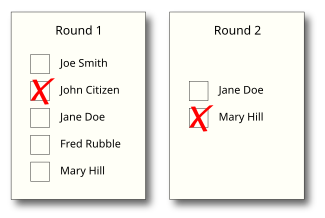
Back اقتراع على دورتين Arabic Segunda vuelta eleutoral AST Балотаж Bulgarian Votadeg unanv gant div dro Breton Dvoukolový volební systém Czech Stichwahl German Segunda vuelta electoral Spanish نظام انتخاباتی دومرحلهای Persian Kierrosvaalitapa Finnish Scrutin uninominal majoritaire à deux tours French

| Part of the Politics series |
| Electoral systems |
|---|
 |
|
|
The two-round system (TRS), also known as runoff voting, second ballot, or ballotage, is a voting method used to elect a single candidate, where voters cast a single vote for their preferred candidate. It generally ensures a majoritarian result, not a simple-plurality result as under first past the post. Under the two-round election system, the election process usually proceeds to a second round only if in the first round no candidate received an absolute majority (more than 50%) of votes cast, or some other lower prescribed percentage.[1] Under the two-round system, usually only the two candidates who received the most votes in the first round, or only those candidates who received above a prescribed proportion of the votes, are candidates in the second round. Other candidates are excluded from the second round.
The two-round system is widely used in the election of legislative bodies and directly elected presidents, as well as in other contexts, such as in the election of political-party leaders or within companies.
The second round of voting must be held after there is sufficient time to count and verify the results of the first round. Second rounds may be held on the same day in smaller settings, or up to one month later, as in the US state of Georgia. France traditionally has a two-week break before the second round.
- ^ "Two-Round System". Electoral Reform Society. Retrieved 7 Nov 2019.
© MMXXIII Rich X Search. We shall prevail. All rights reserved. Rich X Search